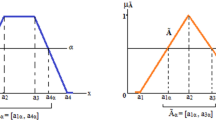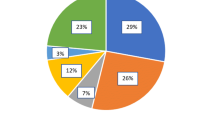Abstract
In the classical EOQ model, acquiring cost of an order would be usually paid while receiving its receipt. Sometimes, the supplier may offer the retailer to pay the entire amount or the fraction of acquiring cost in advance as equal number of payments. The present research discusses the EOQ model with substandard products under fuzzy situation. This model deals with the advance payment on acquiring cost, products with substandard quality, and misclassification errors under repair option without scarcity by providing two models. The first model hypothesizes a remittance situation where the advance payment should be paid before the cycle time with some rate of interest which incurred by the supplier while the second model scrutinizes a situation where the prepayment occurs during the time length of the prior cycle which leads the supplier who would offer some price rebate on prepaid quantities. The proportion of improper items and the two kinds of screening errors are considered as the pentagonal fuzzy numbers [PFNs]. A fuzzy EOQ is framed for analyzing the sample, which can obtain the optimal solution. The impact of fuzziness on fraction of substandard products and investigation errors are illustrated for two models with appropriate examples.




Similar content being viewed by others
References
Salameh, M.K., Jaber, M.Y.: Economic production quantity model for items with imperfect quality. Int. J. Prod. Econ. 64(1), 59–64 (2000)
Papachristos, S., Konstantaras, I.: Economic ordering quantity models for items with imperfect quality. Int. J. Prod. Econ. 100(1), 148–154 (2000)
Konstantaras, I., Skouri, K., Jaber, M.Y.: Inventory models for imperfect quantity items with shortages and learning in inspection. Appl. Math. Model. 36, 5334–5343 (2012)
Sugapriya, C., Jeyaraman, K.: An EPQ model for non-instantaneous deteriorating item in which holding cost varies with time. Electronic Journal of Applied Statistical Analysis 1, 16–23 (2008)
Khan, M., Jaber, M.Y., Bonney, M.: An economic order quantity (EOQ) for items with imperfect quality and inspection errors. Int. J. Prod. Econ. 133, 113–118 (2011)
Al-Salamah, M., Alsawafy, O.: Economic order quantity for items with two types of imperfect quality. An international journal of optimization and control. Theories Appl 2(1), 73–82 (2012)
Hsu, J.T., Hsu, L.F.: An EOQ model with imperfect quality items, inspection errors, shortage backordering, and sales returns. Int. J. Prod. Econ. 143, 162–170 (2013)
Jaber, M.Y., Zanoni, S., Zanavella, L.E.: Economic order quantity models for imperfect items with buy and repair options. Int. J. Prod. Econ. 155, 126–131 (2014)
Zhou, Y., Chen, C., Li, C., Zhong, Y.: A synergic economic order quantity model with trade credit, shortages, imperfect quality and inspection errors. Appl Math Model 40(2), 1012–1028 (2015)
Pimsap, P., Srisodaphol, W.: Economic order quantity model for imperfect items under repair option and inspection errors. Brupa J Sci 23(1), 92–104 (2018)
Sebatjane, M., Adetunji, O.: Economic order quantity model for growing items with imperfect quality. Operat Res Perspect (2019). https://doi.org/10.1016/j.orp.2018.11.004
Alfares, H.K., Afzal, A.R.: An economic order quantity model for growing items with imperfect quality and shortages. Arab. J. Sci. Eng. 46, 1863–1875 (2021). https://doi.org/10.1007/s13369-020-05131-z
Zadeh, L.: Fuzzy sets. Inform Control 8, 338–353 (1965)
Liu, B., Liu, Y.K.: Expected value of fuzzy variable and fuzzy expected value models. IEEE Transact Fuzzy Syst 10(4), 445–450 (2002)
Wang, Z., Tian, F.: A note of the expected value and variance of fuzzy variables. Int J Nonlinear Sci 9(4), 486–492 (2010)
Panda, A., Pal, M.: A study on pentagonal fuzzy number and its corresponding matrices. Pacific Sci Rev B Humanities Soc Sci 1(3), 131–139 (2015)
Wang, X., Tang, W., Zhao, R.: Random fuzzy EOQ model with imperfect quality items. Fuzzy Optim. Decis. Making 6, 139–153 (2007)
Liu, J., Zheng, H.: Fuzzy economic order quantity model with imperfect items, shortage and inspection errors. Syst Eng Procedia 4, 282–289 (2012)
Mahata, G.C., Goswami, A.: Fuzzy inventory models for items with imperfect quality and shortage backordering under crisp and fuzzy decision variables. Comput. Ind. Eng. 64, 190–199 (2013)
Bhaya, S., Pal, M., Nayak, P.K.: Intuitionistic fuzzy optimization technique in EOQ model with two types of imperfect quality items. Adv Model Optim 16(1), 33–50 (2014)
Priyan, S., Palanivel, M., Uthayakumar, R.: Mathematical modeling for EOQ inventory system with advance payment and fuzzy Parameters. Int J Suppl Operat Manag 1(3), 260–278 (2014)
Eshkiki, M.F., Saberifard, N., Ajalli, M.: A fuzzy economic order quantity (EOQ) model with consideration of quality items, inspection errors and sales return. Int J Supp Chain Manag 7(6), 61–71 (2018)
Patro, R., Nayak, M.M., Acharya, M.: An EOQ model for fuzzy defective rate with allowable proportionate discount. OPSEARCH 56, 191–215 (2019)
De, S.K., Mahata, G.C.: A cloudy fuzzy economic order quantity model for imperfect-quality items with allowable proportionate discounts. J Indust Eng Int 15, 571–583 (2019). https://doi.org/10.1007/s40092-019-0310-1
Rajeswari, S., Sugapriya, C.: Fuzzy economic order quantity model with imperfect quality items under repair option. J Res Lepidoptera 51(1), 627–643 (2020). https://doi.org/10.36872/LEPI/V51I1/301058
Supakar, P., Mahato, S.K.: An EPQ model with time proportion deterioration and ramp type demand under different payment schemes with fuzzy uncertainties. Int J Syst Sci Operat Logistics (2020). https://doi.org/10.1080/23302674.2020.1826594
Tahami, H., Fakhravar, H.: A fuzzy inventory model considering imperfect quality items with receiving reparative batch and order. Eur J Eng Res Sci (2020). https://doi.org/10.24018/ejers.2020.5.10.2184
Taleizadeh, A.A.: An EOQ model with partial backordering and advance payments for an evaporating item. Int. J. Prod. Econ. 155, 185–193 (2014)
Taleizadeh, A.A.: An economic order quantity model for deteriorating item in a purchasing system with multiple prepayments. Appl. Math. Model. 38, 5357–5366 (2014)
Teng, J.T., Cárdenas-Barrón, L.E., Chang, H.J., Wu, J., Hu, Y.: Inventory lot-size policies for deteriorating items with expiration dates and advance payments. Appl. Math. Model. 40(19–20), 8605–8616 (2016)
Al-Amin Khan, M., Shaikh, A.A., Panda, G.C., Konstantaras, I.: Two-warehouse inventory model for deteriorating items with partial backlogging and advance payment scheme. RAIRO-Oper. Res. 53, 1691–1708 (2019). https://doi.org/10.1051/ro/2018093
Acknowledgements
The authors would like to thank the referees and editor for their valuable comments and suggestions that greatly help us to improve the quality of this paper. This research was supported by the Ministry of Higher Education Malaysia (MOHE) through Fundamental Research Grant Scheme (FRGS) (FRGS/1/2019/STG06/UTHM/02/1) Grant No: K179.
Author information
Authors and Affiliations
Corresponding author
Rights and permissions
About this article
Cite this article
Rajeswari, S., Sugapriya, C., Nagarajan, D. et al. Optimization in Fuzzy Economic Order Quantity Model Involving Pentagonal Fuzzy Parameter. Int. J. Fuzzy Syst. 24, 44–56 (2022). https://doi.org/10.1007/s40815-021-01111-z
Received:
Revised:
Accepted:
Published:
Issue Date:
DOI: https://doi.org/10.1007/s40815-021-01111-z




